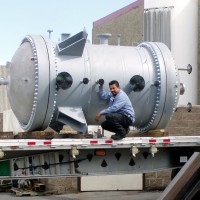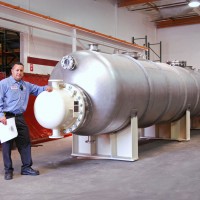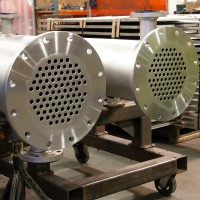TITAN is proud of its long history and successful relationship with Haynes International, Inc., the leading developer, manufacturer and marketer of high-performance nickel-and cobalt-based alloys used in corrosion and high-temperature applications.
TITAN is pleased to be responsible for the first production weldments of C-2000® and the first B-3® Heat Exchanger produced.
Hastelloy Fabrications
TITAN regularly designs, engineers and fabricates the following applications of Hastelloy custom process equipment:
- Hastelloy Heat Exchangers
- Hastelloy Columns
- Hastelloy Condensers
- Hastelloy Reactors
- Hastelloy Pressure Vessels
- Hastelloy Piping Systems
- Hastelloy Pipe
- Hastelloy Spargers
The corrosion-resistant Hastelloy alloys are widely used by the chemical processing industries. The need for reliable performance leads to their acceptance and growth in the areas of geothermal, solar energy, oil and gas and pharmaceutical. The benefits of Hastelloy process equipment include high resistance to uniform attack, outstanding localized corrosion resistance, excellent stress corrosion cracking resistance, and ease of welding and fabrication.
The B-3 alloy possesses outstanding resistance to non-oxidizing acids, such as hydrochloric acid and sulfuric acid. The advantages of B-3 alloy over previous B-family alloys are enhanced thermal stability and improved fabrication characteristics. The recently developed Hastelloy Hybrid-BC1, will handle stronger non-oxidizing acids than C-type alloys and will tolerate oxidizing impurities that B-type alloys will not.
The most versatile of the Hastelloy alloys are the “C-type” alloys. The C-2000 alloy combines outstanding resistance to oxidizing media with superior resistance to non-oxidizing environments and represents a true performance break-through for chemical process equipment applications.
C-22 alloy is particularly resistant to pitting and crevice corrosion; it has been used extensively to protect against the most corrosive FGD systems and the most sophisticated pharmaceutical reaction vessels.
G-30 alloy has been very successful as phosphoric acid heat exchanger tubing and for other process components in the fertilizer industry. G-35 alloy was designed as an improved version of G-30 alloy in these applications of Hastelloy. The high chromium content of both of these alloys make them the premier choices for strong oxidizing solutions and mixed acid pickling services.
| Hastelloy Family of Corrosion-Resistant Alloys | ||||||||||||||||||||||||
|---|---|---|---|---|---|---|---|---|---|---|---|---|---|---|---|---|---|---|---|---|---|---|---|---|
|
||||||||||||||||||||||||
Hastelloy Applications
Hastelloy serves many different applications in these industry categories:
- Chemical Process
- Petrochemical
- Oil & Gas
- Pharmaceutical
- Geothermal
- Sea Water
- Water Desalination
- LNG (Liquefied Natural Gas)
- Biomass
- Mining
- Utilities
- Nuclear Power
- Solar Power
Hastelloy is very well suited to many industrial processes. The following are some of the environments in which Hastelloy is fully resistant*.
|
|
|
For a general guide on corrosion resistance, temperatures and concentrations please see TITAN’s publication, “Corrosion Resistance of Metals in Various Chemical Media” for additional information.*
*Please Note: Final selection of material must be based on actual evaluation of the metal in the corrosive medium under study.
Consult with TITAN if you have need for unique Hastelloy applications and fabrication of any type of process equipment. We can also let you know quickly if another metal might better suit your application. Contact us by phone at (805) 487-5050 or toll-free (877) 487-5050 or email info@titanmf.com.
Masa Depan Slot Online: Tren, Teknologi, dan Gaya Main yang Bikin Penasaran
Slot online sekarang udah jadi salah satu hiburan favorit banyak orang. Dulu mah, mau main slot harus ke kasino langsung. Sekarang? Cukup modal HP sama internet, lo udah bisa muter reel ledak188 kapan aja dan di mana aja. Tapi tunggu dulu, ini baru permulaan. Dunia slot online masih akan berkembang jauh lebih seru dan gila dari yang kita bayangin.
Di artikel ini, kita bakal kupas tuntas gimana sih slot online gokil33.link bakal berubah di masa depan—mulai dari teknologi keren, perubahan kebiasaan main, sampai gimana efeknya ke ekonomi dan masyarakat.
1. Teknologi Canggih yang Bikin Slot Online Makin Gokil
Jaman sekarang, game slot udah bukan cuma soal muter dan nunggu simbol cocok. Teknologi yang makin gila bikin pengalaman main dewihoki.top makin nyatu kayak lagi nonton film animasi atau bahkan jalan-jalan di dunia virtual.
Visual dan Animasi Kelas Dewa
- Bayangin main slot laoban188 dengan grafis 3D, animasi yang halus banget, dan efek suara yang bikin merinding. Itu semua bakal jadi standar.
- Tema game bakal makin variatif—ada yang temanya petualangan, film terkenal, dunia fantasi, sampai budaya lokal.
- Setiap putaran roketslot bukan cuma soal menang, tapi juga soal menikmati dunia yang keren dan imersif.
Slot dengan AR dan VR? Gas Pol!
- Teknologi Virtual Reality (VR) bikin lo bisa seolah-olah jalan di kasino beneran, liat mesin slot di kiri kanan, dan interaksi langsung sama game-nya.
- Dengan Augmented Reality (AR), lo bisa muter reel langsung dari meja makan lo—slot muncul lewat kamera HP dan lo tinggal main.
- Intinya, slot mmctoto online ke depan bakal makin nyatu sama dunia nyata dan pengalaman main jadi makin mind-blowing.
2. Slot Online dan Dampaknya ke Ekonomi Global
Lo kira slot sstoto cuma buat hiburan? Salah besar. Industri ini sekarang udah jadi bagian dari ekonomi digital yang gede banget, dan bakal makin penting di masa depan.
Nambah Lapangan Kerja di Banyak Bidang
- Karena slotmaxwin online makin rame, perusahaan-perusahaan juga butuh banyak tenaga: programmer game, ilustrator, customer service, marketing, sampai spesialis keamanan data.
- Industri game surga11 nggak cuma kasih hiburan, tapi juga peluang kerja buat anak-anak muda kreatif dan tech savvy.
Sumber Pemasukan Negara Lewat Pajak
- Negara-negara yang melegalkan judi online bisa dapet duit banyak dari pajak perusahaan game slot haha788.
- Duit pajak ini bisa dipakai buat bangun infrastruktur, bantu program pendidikan, dan tambahin anggaran kesehatan.
3. Gaya Main Pemain Slot yang Beda Banget dari Dulu
Karena slot teh4d udah online dan bisa diakses 24/7, cara orang main juga berubah total. Pola perilaku pemain sekarang udah beda jauh dari era mesin slot jadul di kasino.
Main Slot Jadi Lebih Gampang dan Murah
- Sekarang lo nggak perlu keluar rumah, cukup buka aplikasi atau situs dewi5000, dan langsung main.
- Nggak perlu modal besar, karena banyak slot xxtoto yang bisa dimainin dengan taruhan kecil.
- Ini bikin siapa aja bisa ikutan—dari yang cuma iseng nyoba, sampai yang emang hobi banget main di surga22.
Slot Sosial? Seru Banget!
- Slot ggtoto online sekarang banyak yang punya fitur komunitas kayak leaderboard, turnamen real-time, dan mode multiplayer.
- Lo bisa saingan sama pemain lain, saling share kemenangan, bahkan ngobrol lewat fitur chat.
4. Regulasi Bakal Makin Ketat, Tapi Demi Kebaikan
Semakin berkembang industrinya, semakin ketat juga aturan mainnya. Tapi tenang, semua ini buat jaga pemain dewi288 dan bikin slot online tetap aman.
Aturan Negara yang Makin Detail
- Banyak negara udah punya regulasi ketat buat judi online kayak verifikasi umur, transparansi sistem, dan perlindungan hak pemain istana2000.
- Di masa depan, makin banyak negara bakal bikin peraturan serupa supaya industri slot liga2000 tetap fair dan bertanggung jawab.
Keamanan Data Jadi Prioritas Utama
- Karena lo harus daftar naga2000 dan masukin data pribadi, keamanan data jadi hal penting banget.
- Situs slot online slot2000 ke depan bakal pakai enkripsi, sistem keamanan berlapis, dan proteksi identitas pemain.
5. Cara Bayar yang Makin Simpel dan Canggih
Buat main slot online, pasti butuh metode pembayaran. Nah, ke depan, cara-cara lama bakal mulai ditinggalin dan diganti aman788 yang lebih modern dan cepat.
Cryptocurrency Makin Jadi Pilihan Utama
- Bitcoin, Ethereum, dan kawan-kawannya sekarang udah banyak diterima sebagai alat transaksi di ayo788.
- Kelebihan pakai kripto: transaksi cepat, biaya rendah, dan privasi terjaga.
Pembayaran Digital dan Mobile Wallet Naik Daun
- Metode kayak GoPay, OVO, Dana, PayPal makin populer dan bikin transaksi hao788 makin gampang.
- Tarik dana dan deposit jadi bisa langsung dari HP tanpa harus ribet ke bank.
6. Slot Online dan Isu Perjudian Sehat
Namanya juga game yang berhubungan dengan duit, pasti ada risiko kecanduan. Tapi untungnya, btstoto sekarang makin sadar pentingnya game yang sehat dan bertanggung jawab.
Fitur Batasan Waktu dan Budget
- Pemain bydtoto bisa atur sendiri limit waktu main, batas pengeluaran mingguan, dan fitur jeda otomatis.
- Ini semua buat ngingetin lo biar mainnya tetap fun, nggak bablas sampe rugi.
Teknologi Deteksi Kecanduan
- AI bisa pantau pola main pptoto dan kasih warning kalau pemain mulai kecanduan.
- Bisa juga otomatis aktifin fitur istirahat buat jaga pemain tetap sehat secara mental dan finansial.
7. Masa Depan Slot yang Imersif Abis
Nggak cuma dari segi visual dan suara, slot online rrtoto juga bakal makin nyatu sama dunia nyata—bikin lo betah main karena berasa masuk ke dunia game beneran.
Cerita dan Petualangan yang Bikin Nagih
- Banyak slot ligatoto di masa depan bakal punya jalan cerita, karakter, dan misi-misi yang bisa diikuti.
- Lo bisa unlock bab baru, ikutan tantangan mingguan, dan dapet bonus lewat progress game mcmtoto.
Dunia Virtual yang Beneran Hidup
- Masuk ke dunia kasino virtual pakai headset VR, jalan-jalan antar mesin slot, ngobrol sama pemain lain, dan pilih game langsung di dunia maya.
8. Slot Online dan Tren Globalisasi
Slot online gghoki udah buka peluang buat pemain dari seluruh dunia. Tanpa harus ke negara lain, lo bisa main bareng orang-orang dari benua lain.
Pemain dari Seluruh Dunia Jadi Satu Komunitas
- Bisa ikut turnamen internasional dan bersaing di leaderboard global.
- Main slot hahagacor dengan tema budaya dari berbagai negara bikin pengalaman makin kaya.
Operator Game Bisa Jangkau Pasar Baru
- Developer naga5000 sekarang nggak cuma fokus ke satu negara, tapi udah multilingual dan support banyak mata uang.
- Pasar Asia, Amerika Latin, Afrika makin terbuka buat slot online.
Kesimpulan: Masa Depan Slot Online Cerah dan Seru Banget
Slot online surga88 bukan lagi sekadar game iseng. Ini udah jadi industri hiburan global yang terus berkembang dengan teknologi mutakhir, aturan yang makin jelas, dan komunitas yang makin rame.
- Lebih realistis dengan VR, AR, dan animasi tingkat tinggi.
- Lebih global karena akses tanpa batas dan komunitas internasional.
- Lebih aman karena regulasi ketat dan sistem deteksi kecanduan.
- Lebih seru main slot terpercaya Indonesia dengan gameplay interaktif, cerita, dan fitur sosial.
Siap-siap aja, karena dunia slot online bakal makin gila, makin kreatif, dan makin seru buat dijelajahi. Lo udah siap ikutan muter reel di masa depan?



